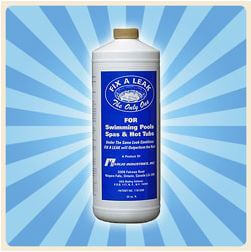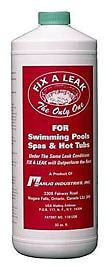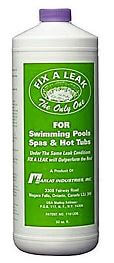how to find a leak in a pool
 Fix-A-Leak is an emulsion product that acts like platelets and plasma that forms a blood clot over skin cuts. Microscopic layers of sodium silicate pile on top of each other to form a clot, and seal up small holes, cracks and voids, up to 1/8″ wide.
Fix-A-Leak is an emulsion product that acts like platelets and plasma that forms a blood clot over skin cuts. Microscopic layers of sodium silicate pile on top of each other to form a clot, and seal up small holes, cracks and voids, up to 1/8″ wide.
Does it work? Not every time, but yes it can form a semi-permanent repair when applied correctly. The correct process depends on what you are trying to fix with Fix-A-Leak, but it is a detailed procedure that really should be a last resort.
In other words, Fix a Leak should be employed only after extensive testing to find a pool leak, or to isolate the pool leak to a particular plumbing line, such as a skimmer, drain or return line. The best repair is of course to pinpoint the leak to an exact location using a leak detection expert, and then dig it up and replace the broken PVC pipe or fittings. Or to find the leak in the pool shell or gasketing and make a proper patch inside the pool. However, the best repair at the moment may be using Fix-A-Leak.
Fix-A-Leak is suited for many types of small leaks on hot tubs or spas, but it does require process and procedure. You don't just pour it in the pool and walk away. I spoke with the people from Marlig at a recent pool trade show event, and they impressed on me how important the process is, to correctly use Fix-A-Leak or Stop Leak in a pool or spa.
Pools with many very small voids or widespread cracking
There are situations where a vinyl liner can suffer track or golf cleats, or small slits from a skateboard or other non-pool toys. If you can patch it with a vinyl repair sealant, that is the best route to take, but if there are many very small holes (not tears, rips or large holes), you can expect some level of success with Fix-A-Leak treatment. For gunite or fiberglass pools that have small, slow leaks, or seepers and weepers that have eluded your best leak detection efforts, you can also try the Fix-A-Leak "Shotgun" technique, and put enough of it (1 Qt per 20,000 Gallons), to hopefully plug the leak, or at least slow it somewhat.
 1. Bypass the Filter. Fix-A-Leak will clog your filter fast. Set the Multiport valve to Recirculate, or for Push-Pull slide valves and Cartridge filters, remove the DE grids or filter sand, and reassemble the tank together tightly without the filter media. Be sure your chlorine level is on the high side, as you won't be filtering for a few days.
1. Bypass the Filter. Fix-A-Leak will clog your filter fast. Set the Multiport valve to Recirculate, or for Push-Pull slide valves and Cartridge filters, remove the DE grids or filter sand, and reassemble the tank together tightly without the filter media. Be sure your chlorine level is on the high side, as you won't be filtering for a few days.
2. Soak Fix-A-Leak in a bucket of warm water for ten minutes. Then shake well for 30 seconds to mix the contents well.
3. With pump running, add Fix-A-Leak directly to the skimmer or in front of any suction outlet. Add 1 Qt (32 oz) per 20,000 gallons of pool water.
4. Adjust suction valves after all Fix-A-Leak has been sucked into the pump. Close the skimmers most of the way, and open the main drain valve fully. Fix-A-Leak is heavy and particles will sink to the lowest point of the pool, so adjust valves to pull mainly from the main drain, or set up a pool vacuum hose and head, and leave it in the deepest part of the pool. Use your pool brush or pool cleaner (without a bag) to stir up settled Fix-A-Leak.
5. Continue to Run the Pump for 8-10 hours. Then shut off pump for 48-72 hours, brushing 3-4x per day to stir up the emulsion and provide some water circulation. Add water if needed to maintain water level, and do not use the pool during treatment.
6. Vacuum pool to waste, to remove settled silicate material. Return filter to operation and shock pool to raise chlorine level if needed. If you cannot vacuum to waste, clean DE grids or cartridges fully by removing from tank and hosing clean after vacuuming.
Cracks or voids around wall and floor fittings
Anytime a pipe, drain, skimmer or pool light comes through a wall, there is a potential for leaks. These can be dye tested (with the pump off) to determine if there is a leak. And once again, the best repair may be to chip out the area and pack it full of plaster mix, use an epoxy pool putty, or in the case of a vinyl pool, replace the faceplate and gasket around a leaking wall fitting. However, fix a leak can be directly administered to small underwater leaks around wall and floor fittings, lights and rail sockets, skimmers and returns, using a squeeze bottle.
1. Shut down the pump and allow the water to become still.
2. Soak Fix-A-Leak in warm water for ten minutes, then shake well for 30 seconds to mix the contents well.
3. Transfer Fix-A-Leak to a squeeze ketchup bottle or water bottle, to administer underwater to the crack.
4. Slowly squeeze out the emulsion, if it is actually leaking, it will draw Fix-A-Leak into the crack by suction.
5. After several treatments, dye test to confirm leak has stopped. Allow 48 hrs before turning on the pump.
Cracks or voids in PVC pipe
When you have isolated your pool leak, through a series of if-then testing, down to one or two particular plumbing lines, you can use Fix-A-Leak to repair cracked pipes or fittings, when damage is not extensive. Again, the best repair would be to isolate the near exact location, using listening devices, and then cut the deck, dig down and repair the pipe, or abandon an old line and connect a new line from the break, back to the equipment pad. However, if you want to use Fix-A-Leak to seal up underground plumbing cracks, it does work when applied using what the manufacturer Marlig refers to as 'reversing the water flow'.
 1. Cut the pipe that is leaking at the equipment, at a location that allows you to reconnect easily later, and in a way that you can slip a hose inside of the pipe, which may mean removing a few inches of pipe, or cutting more than one pipe, so the suction manifold can be move aside.
1. Cut the pipe that is leaking at the equipment, at a location that allows you to reconnect easily later, and in a way that you can slip a hose inside of the pipe, which may mean removing a few inches of pipe, or cutting more than one pipe, so the suction manifold can be move aside.
2. Isolate the section of pipe by plugging the other end of the pipe, at the pool. For threaded 1.5″ skimmers, returns or drains, use a SP1022C plug with o-ring, or use a #8 or #9 winter expansion plug, to plug the pool end of the pipe. For 2″ lines use a #9 or #10 winter plug. Be sure that a tapered rubber plug is very tight, use pliers on the wing nut if needed.
3. Fill the pipe with water from a garden hose, and after shaking well, add 1/2 bottle (16 oz) of Fix-A-Leak directly to the pipe where you cut the pipe, just pour it in there.
4. Connect a Drain King to your garden hose, and insert it into the pipe. Turn on the hose spigot very softly, about 1/4 way, just enough so the Drain King expands to fit the pipe, and pressurizes the line to between 5 – 10 psi. Allow the hose to run at a low pressure for several hours. Shut off the water and add another half bottle (16 oz) of Fix-A-Leak, and repeat the process again but this time increase water flow to 1/2 way open for thirty (30) minutes, then 3/4 open for 30 minutes, followed by fully open for another hour, with pressure in the 10-20 psi range.
5. Remove the Drain King, fill the pipe with water and mark water level. Cover to prevent evaporation, and check on it again in 24 hours. If water level has dropped, repeat treatment again. If water level is stable and holding, allow it to set for another 24 hours, then reassemble plumbing, remove plug(s) in pool, and start up filter system again.
In this process you are using the water pressure of the Drain King to force the emulsion into the crack in the pipe, slowly at first, and then eventually with more pressure, as the layers build up.
You don't have to use a Drain King to pressurize the line, you could also use plumbing fittings to create a pressure testing stick or hose adapter rig, or you don't even have to use water, you can use an air compressor to pressurize the line to between 5-10 psi initially, then up to 10-20 psi afterwards.
And, you don't even need to cut the pipe, as long as you can disassemble a valve, or use a long hose and funnel to deliver the Fix-A-Leak into the pipe, and insert the Drain King into the pump (facing towards the pool). then use the valves to pressurize only the one specific line.
how to find a leak in a pool
Source: https://blog.intheswim.com/using-fix-a-leak-to-fix-pool-leaks/
Posted by: goodsoncined1957.blogspot.com

0 Response to "how to find a leak in a pool"
Post a Comment